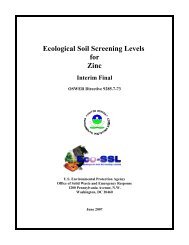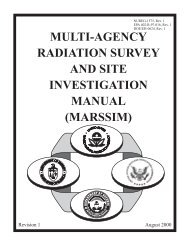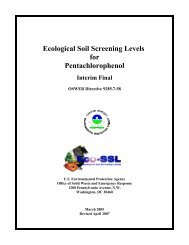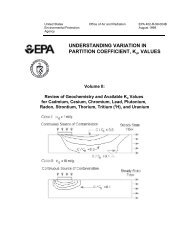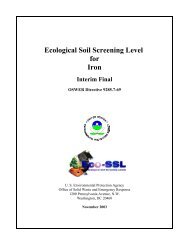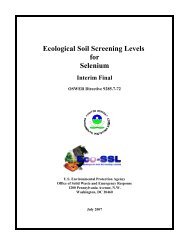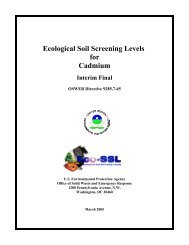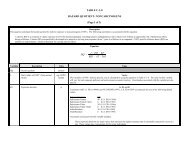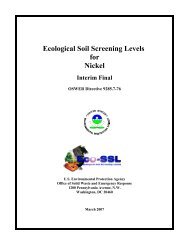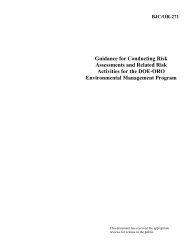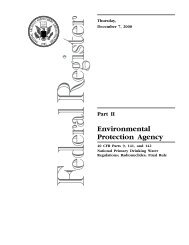Chromium - The Risk Assessment Information System
Chromium - The Risk Assessment Information System
Chromium - The Risk Assessment Information System
You also want an ePaper? Increase the reach of your titles
YUMPU automatically turns print PDFs into web optimized ePapers that Google loves.
1.0 INTRODUCTION<br />
Ecological Soil Screening Levels (Eco-SSLs) are concentrations of contaminants in soil that are<br />
protective of ecological receptors that commonly come into contact with and/or consume biota<br />
that live in or on soil. Eco-SSLs are derived separately for four groups of ecological receptors:<br />
plants, soil invertebrates, birds, and mammals. As such, these values are presumed to provide<br />
adequate protection of terrestrial ecosystems. Eco-SSLs are derived to be protective of the<br />
conservative end of the exposure and effects species distribution, and are intended to be applied<br />
at the screening stage of an ecological risk assessment. <strong>The</strong>se screening levels should be used to<br />
identify the contaminants of potential concern (COPCs) that require further evaluation in the<br />
site-specific baseline ecological risk assessment that is completed according to specific guidance<br />
(U.S. EPA, 1997, 1998, and 1999). <strong>The</strong> Eco-SSLs are not designed to be used as cleanup levels<br />
and the United States (U.S.) Environmental Protection Agency (EPA) emphasizes that it would<br />
be inappropriate to adopt or modify the intended use of these Eco-SSLs as national cleanup<br />
standards.<br />
<strong>The</strong> detailed procedures used to derive Eco-SSL values are described in separate documentation<br />
(U.S. EPA, 2003). <strong>The</strong> derivation procedures represent the collaborative effort of a<br />
multi-stakeholder team consisting of federal, state, consulting, industry, and academic<br />
participants led by the U.S. EPA, Office of Solid Waste and Emergency Response.<br />
This document provides the Eco-SSL values for chromium and the documentation for their<br />
derivation. This document provides guidance and is designed to communicate national policy on<br />
identifying chromium concentrations in soil that may present an unacceptable ecological risk to<br />
terrestrial receptors. <strong>The</strong> document does not, however, substitute for EPA's statutes or<br />
regulations, nor is it a regulation itself. Thus, it does not impose legally-binding requirements on<br />
EPA, states, or the regulated community, and may not apply to a particular situation based upon<br />
the circumstances of the site. EPA may change this guidance in the future, as appropriate. EPA<br />
and state personnel may use and accept other technically sound approaches, either on their own<br />
initiative, or at the suggestion of potentially responsible parties, or other interested parties.<br />
<strong>The</strong>refore, interested parties are free to raise questions and objections about the substance of this<br />
document and the appropriateness of the application of this document to a particular situation.<br />
EPA welcomes public comments on this document at any time and may consider such comments<br />
in future revisions of this document.<br />
2.0 SUMMARY OF ECO-SSLs FOR CHROMIUM<br />
<strong>Chromium</strong> is the 21 st most common element in the earth’s crust. <strong>Chromium</strong> ore deposits are<br />
primarily used for metallurgical applications such as the production of stainless steel. Other uses<br />
include wood preservation, leather tanning, pigments, and refractories (Barnhardt, 1997). In the<br />
natural environment, chromium occurs as two oxidation states or valences: chromium (III) and<br />
chromium (VI).<br />
Eco-SSL for <strong>Chromium</strong> 1<br />
April 2008



